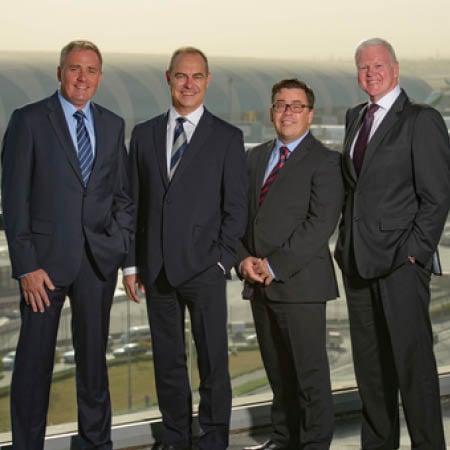dnata knows travel, and it knows airports. Established in 1959, dnata is part of The Emirates Group. Now one of the largest combined air service companies in the world, dnata provides aircraft ground handling, cargo services, travel services, and inflight catering in more than 38 countries across the globe and employs more than 27,000 people. It operates out of 75 airports on five continents, and has seen a massive increase in profit in recent years.
The CEO Magazine interviewed dnatas four Divisional Senior Vice Presidents (DSVP)Stewart Angus, DSVP of International Airport Operations; Jon Conway, DSVP United Arab Emirates Airport Operations; Robin Padgett, DSVP Catering; and Iain Andrew, DSVP Travel. They shared their opinions on dnatas recent growth, the secrets to success, and whats next for the company.
How has the aviation industry been changing, and what does that mean for dnata? Robin: Weve seen over the past 20 years a cycle and a change, and a very interesting one. Weve seen a segment where the low-cost carriers operate and really take apart the shorthaul market and the offering they have for their customers, which has been incredibly interesting. Then weve seen, particularly from the Gulf carriers and some of the Asian carriers, a race to the top where they want to differentiate themselves in terms of the product offerings they have. So, for a business in dnatas case, those two very different aviation business models present magnificent opportunities and allow us to work with our customers to deliver their vision.
dnata saw some really big growth in the past year in the cargo area in particular.
Stewart: We grew a lot last year. The biggest area of growth was cargo; we actually opened 10 new cargo terminals during the last calendar year, which is a record for us and probably for anyone in our industry. We opened dnata City, which is a brand-new, 20,000-square-metre cargo facility at Heathrow. We opened up a number of regional airports in the UK Newcastle, Birmingham, Gatwick, East Midlands, and Glasgow and we opened new sheds in Manchester and Karachi, Pakistan. So those drove a big increase in volume for us.
How do you manage the high levels of growth the aviation industry is experiencing in the UAE?
Jon: That’s a very, very good question, and it actually occupies most of our time at the moment, thinking about how we are going to manage the growth going forward. By the numbers of international passengers, Dubai International is the busiest airport in the world. The problem we have at the moment and the challenge we have here is the speed of the growth. It’s not something we can do in isolation. We work hand in glove with the airport authority, the airport company, and the two home-based carriers, Emirates and Fly Dubai. We recently had a big session with the CEOs of the airlines and the airport to talk about some of the numbers and the projected activity levels we are seeing now. The growth the region is experiencing is incredible. The numbers that we expected to see in 2018 and 2020 we are now seeing in 2015, and likewise plans we had for 2020 we expect now in 2018.



